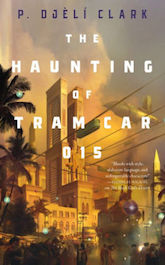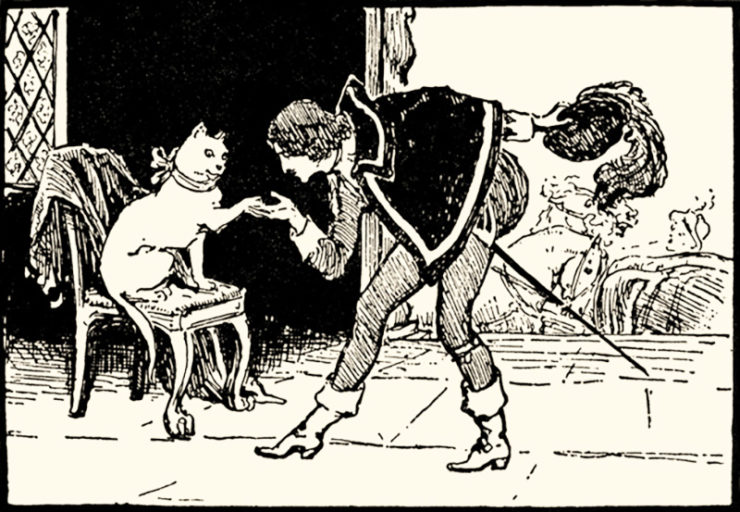“Either become a woman, or make me a cat.”
The image of a beast hiding deep within an enchanted forest in an enchanted castle, waiting to be transformed through love, is generally associated with, well, male beasts. The beasts also typically have a frightening appearance: they are often bears, or lions, or something too terrifying to describe.
But sometimes, that enchanted beast is a girl. As in Madame d’Aulnoy’s novelette, “The White Cat.”
Marie-Catherine Le Jumel de Barneville, Comtesse d’Aulnoy, (1650-1705) lived a life that was either mostly fabulous or mostly fabricated, depending upon precisely who you spoke to. One of those fabulous fabrications: accusing her husband of committing high treason, an allegation that eventually forced her to flee France for a time. Despite her exile, she later purchased a house in Paris in the late 1680s, without her estranged husband’s assistance but with his at least tacit permission, and established a literary salon that in turn helped establish the passion for the elaborate French salon fairy tales.
Madame d’Aulnoy’s tales, designed to entertain an audience for at least a couple of hours, tended to be long, intricate, and highly political. She could not openly criticize Louis XIV and his regime, but she could have strong feelings about it, and, even more so, the way the regime frequently entrapped aristocratic women, leaving them unable to choose their own fortunes and careers. This was equally true for less aristocratic women, but Madame D’Aulnoy’s tales show little if any interest in the problems of the lower classes. Or men. She was fixated on aristocratic women, as “The White Cat” shows.
“The White Cat” opens with an aging king terrified that his three brave and handsome sons are about to overthrow him and take over his kingdom, not an entirely unknown or unrealistic threat during d’Aulnoy’s life. The king decides that his best bet is to make use of something straight out of fairy tales—send all three sons on long, largely frivolous quests to ensure that they are too distracted to plot revolution. His first request: find a cute dog, promising that whichever son finds the cutest dog will get the kingdom.
All three of them set out to look for cute dogs. I would not have thought that finding a cute dog would be all that difficult, but then again, I like dogs, and as this story is about to demonstrate, most of the characters in this tale are really more cat people. Madame d’Aulnoy assures us that the oldest two sons had various dog-hunting adventures, but in pure fairy tale fashion, she chooses to ignore the oldest two, and instead focus on the youngest.
Also in pure fairy tale fashion, this youngest prince is of course ideal: handsome, well mannered, cheerful, and brave. He even has—this is spelled out in the tale—excellent teeth, ensuring that the rest of the story will be free from dental issues. That said, I must say that, for all of Madame d’Aulnoy’s efforts to get me on the side of this prince, and to get me to recognize this prince as the most accomplished, most charming, and most astonishing prince ever, it does not exactly take much for her to turn me completely against this prince; as part of this Quest for the Perfect Dog, the prince keeps buying new dogs, then letting the old dogs go every time he finds a new, apparently better/more charming dog. Which is, again according to the text, about 30,000 adorable dogs thinking that they finally had a human at last, only to be abandoned a few days later, which seems horrifically harsh on the dogs. So, I’m against this prince from the start.
Anyway. While dog-hunting, the prince happens upon an exquisitely beautiful palace in the forest, as fairy tale characters do, leaving the rest of us gloomily looking at our GPS devices and wishing we’d brought along more chocolate for this forest expedition. Moving on. Naturally, he enters the castle, which equally naturally is staffed by invisible singing servants—that is, invisible right up to the moment where disembodied hands start to undress and then dress him. Ugh. After this the hands escort him to dinner—a dinner where the music is composed of cat meows (considerably less tuneful than the later songs in Disney’s Aristocats) and where his companion is a beautiful little white talking cat.
SPOILER ALERT this is an enchanted castle.
The delighted prince spends a year there, forgetting everything else, and, perhaps most importantly from my point of view, stops looking for dogs and thus ending their torture, which, come to think of it, may have been the plan of the cats all alone. I mean, sure, cats aren’t always known for their goodwill towards dogs, but some cats and some dogs have become friends, and I have to assume that even the most hard-hearted cat would have felt terrible about the dog issue. Moving on. At the end of the year, the white cat sends him back home, with a tiny dog concealed in an acorn.
The other two princes have also found dogs (it’s not clear if they, too, abandoned several other dogs along the way) but their admittedly adorable and beautiful dogs can’t exactly compete with a tiny dog capable of doing a Spanish dance. The king, meanwhile, decides to send the princes out yet again—this time on a hunt for fine cloth. The prince returns to the white cat and spends another enchanted year with her, departing with the cloth hidden in yet another nut. The king ups the requirements a third time: forget cute dogs or fine cloth, they need to bring back a beautiful maiden. The prince, not surprisingly, decides to spend another year with his cat.
At the end of that year, the cat asks him to cut off her head.
This, as it turns out, is the start of a second tale—a story of a princess trapped in a tower thanks to the foolish whims and demands of her mother, a princess who defiantly marries a king without permission from her guardians, and finds herself and the aristocrats in her palace transformed into cats until she finds a man who looks exactly like that king.
“The White Cat” is not exactly original. Its themes, motifs and basic plots, both of the “enchanted cat” and the “princess in a tower,” can be found in numerous other stories, many—perhaps most—better written. The introduction of a story within a story in the second half feels more than a bit unwieldy—to the point where several English translations have left it out entirely, just skipping from the cat beheading to the last few paragraphs. Plot holes are abundant, and certain details remain inexplicable—not least, the question of just why getting transformed into a beautiful cat capable of granting virtually every request on earth is such a terrible fate, and also, what happened to the tiny dog in the acorn, and also, just how does this prince resemble the king so exactly? Were they somehow related? Or did some kind—or practical—fairy realize that the cat had been punished enough already, or was presenting far too much of a drain on the fairy resources, what with all of the magical weaving and the summoning of jewels and the creation of cat orchestras, and really, it was best for everyone to make a prince look like the former king?
Buy the Book


The Haunting of Tram Car 015
Not to mention that the original problem presented by the story—who, exactly, is going to take control of this kingdom—never really does get solved.
I suspect, too, that for many people, the “Oh, you got transformed into a cat and now have to live a life of endless enchanted luxury waited on by mostly invisible servants, with no need to work, ever, and with your only companions other cats capable of writing poetry and novels” is not exactly the worst sort of punishment they can envision. I’ll be honest. It sounds like precisely my ideal life, and I was not exactly surprised—nor baffled—to see the prince begging to be transformed into a cat. Which is to say, I’m having a hard time with the “SAVE ME, PRINCE, BY CUTTING OFF MY HEAD” deal here. No, princess. Remain a cat. Take a lot of naps in between snacking on things. Life could be much worse.
Also, this prince? Does less than anyone else in any fairy tale ever to earn his happy ending. I mean, he abandons a lot of adorable dogs, rides a horse, uses other people’s labor to argue that he should win his brother’s throne, spends three years delighting in life at an enchanted castle, and cuts off the head of a cat. That’s—yeah, that’s it.
And it’s more than a touch disturbing to realize that the men trapped as beasts can be saved through marriage, massive travelling and sacrifice on the part of the women, and a kiss, while the girl trapped as a cat can only be rescued through sudden violence.
It is a not particularly subtle comment on the issues faced by aristocratic women in Madame d’Aulnoy’s day. Madame d’Aulnoy had no way of ridding herself of a deeply unwanted husband: she had to wait for death to remove that obstacle. But she also saw men rescue themselves through using the financial resources of wealthy women, usually through marriage—as the prince does in this story, and watched men imprison their wives for small offenses—as a side character does in this story. The women in this story find themselves trapped in towers and enchanted palaces, and find themselves unable to rescue people about to be sacrificed to dragons. The men travel around freely, occasionally eaten by dragons (ok, once), but for the most part able to make their own choices—and more than once, make the choices that affect the women.
But for me, at least, the power of the story stems less from its critiques of aristocratic French society (not exactly the most sympathetic group in history), but from the little details. Like the throwaway line that royal princes were expected to be able to perform music and paint. (This may well have been intended as a nasty crack at the ruling Bourbon family, whose members were better known for patronizing art than for creating it.) Or the other throwaway line suggesting that magical castles are decorated with images inspired by other fairy tales, which, let’s just say it, is marvelous. Especially since many of the fairy tales mentioned were Madame d’Aulnoy’s kind nods to other authors. Or the little side scene of the prince managing to earn a pardon for four cats who conspired with—I hope you’re prepared for the horror—two rats to eat food meant for the dinner of the white cat. (If you weren’t prepared for that horror, I’m sorry.) A side scene that allowed Madame d’Aulnoy to make another graceful nod to fellow author and poet Jean de la Fontaine. The way the fairies ensure that this princess in a tower gets to have a parrot and a dog to make sure she’s not all that lonely.
The length and structure of “The White Cat” presumably explains why it never really achieved the popularity of other French salon fairy tales, although Andrew Lang collected a translation for his The Blue Fairy Book (1889) and multiple translations are widely available online. But if it never achieved the popularity of “Cinderella,” it did make its own, forthright statements about women—and helped establish the genre of the French salon fairy tales. An impressive achievement for a woman able to see the restrictions and traps created by her society.
Mari Ness lives in central Florida.










